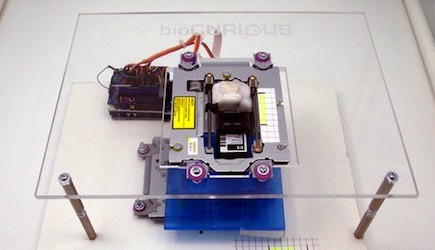Printing Living Cells With a $150 Open Source Bioprinter
January 29, 2013
on
on

Industry grade bioprinters are already capable of printing living tissue from human cells. Currently the 3D tissue is used in lab environments for drug testing but predictions are that in five to ten years blood vessels and even organs can be printed for transplantation purposes. But this kind of hardware is very expensive and generally not available for enthusiastic tinkerers.
So people at the biotech hackerspace Biocurious decided to built their own.
Bioprinting works very much like 3D printing. A movable print head deposits layer-upon-layer producing a 3D object but instead of using plastics or ceramics the cartridges are filled with biological material.
The Biocurious team led by computational biologist Patrik D’haeseleer built the bioprinter using a stripped HP 5150 inkjet printer. They thoroughly rinsed the cartridges to avoid contaminating the biological material with residual ink. To position the printer nozzle over an x-y platform the team used stepper motors salvaged from CD-ROM drives. The setup is controlled by two Arduino boards. D’haeseleer uploaded detailed instructions to instructables.com
Emulating multimillion dollar lab equipment with cheap DIY designs is an essential part of biohacking. As geneticist and DIY bioengineer Cathal Garvey explained in an earlier article on biohacking: ‘I am trying to make every level of biotechnology available for anyone because this is the most fundamental technology of them all. This is the code of life.’ And to democratize bioengineering people need to have access to the necessary tools.
This iteration of the DIY printer allows for simple experiments only. D’haeseleer suggests printing two microbial species at different distances from each other to study metabolic interactions or printing cells into 3D objects. But open source has a tendency to accelerate development and bring down cost. So maybe in a few years time we won’t have band aids in our first aid kit but little bioprinters generating replacement tissue from our own cells.
Image: Biocurious
So people at the biotech hackerspace Biocurious decided to built their own.
Bioprinting works very much like 3D printing. A movable print head deposits layer-upon-layer producing a 3D object but instead of using plastics or ceramics the cartridges are filled with biological material.
The Biocurious team led by computational biologist Patrik D’haeseleer built the bioprinter using a stripped HP 5150 inkjet printer. They thoroughly rinsed the cartridges to avoid contaminating the biological material with residual ink. To position the printer nozzle over an x-y platform the team used stepper motors salvaged from CD-ROM drives. The setup is controlled by two Arduino boards. D’haeseleer uploaded detailed instructions to instructables.com
Emulating multimillion dollar lab equipment with cheap DIY designs is an essential part of biohacking. As geneticist and DIY bioengineer Cathal Garvey explained in an earlier article on biohacking: ‘I am trying to make every level of biotechnology available for anyone because this is the most fundamental technology of them all. This is the code of life.’ And to democratize bioengineering people need to have access to the necessary tools.
This iteration of the DIY printer allows for simple experiments only. D’haeseleer suggests printing two microbial species at different distances from each other to study metabolic interactions or printing cells into 3D objects. But open source has a tendency to accelerate development and bring down cost. So maybe in a few years time we won’t have band aids in our first aid kit but little bioprinters generating replacement tissue from our own cells.
Image: Biocurious
Read full article
Hide full article



Discussion (0 comments)